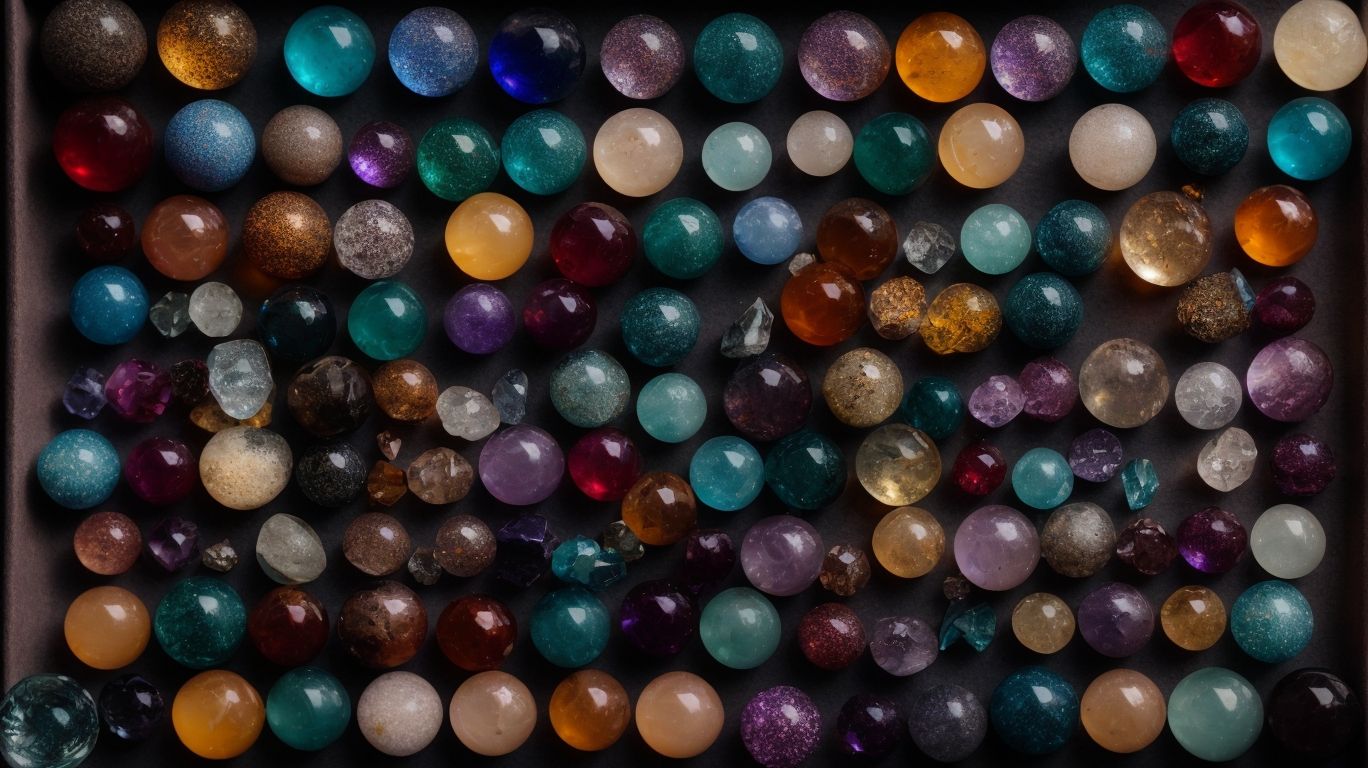
Crystals Through the Ages: Their Historical Significance in Ancient Cultures
Crystals have captivated human fascination for centuries, with their unique beauty and perceived mystical properties. From the ancient civilizations of Egypt and Greece to the indigenous cultures of Native America and the religious practices of Hinduism and Buddhism, crystals have played a significant role in shaping beliefs and traditions across diverse cultures.
This article will delve into the historical significance of crystals in various ancient cultures, examining their beliefs and meanings associated with healing, spirituality, protection, and ornamentation. We will explore how these ancient beliefs have influenced the modern-day use of crystals in practices such as healing, meditation, and decorative arts. Join us on a fascinating journey through time as we uncover the enduring allure and cultural impact of crystals through the ages.
What Are Crystals?
Crystals, also known as gemstones, hold a significant place in spiritual and metaphysical practices for their healing and mystical properties.
Their unique properties, such as their ability to amplify energy, resonate with specific chakras, and enhance meditation, have fascinated people for centuries. These remarkable stones have been used by different cultures across the world for their healing and protective qualities. From the ancient Egyptians who believed in the power of lapis lazuli to the Chinese who treasured jade for its balancing properties, crystals have a rich and diverse historical significance.
Their potential for enhancing spiritual growth and promoting emotional well-being continues to inspire individuals to harness their energy for healing and personal transformation.
How Have Crystals Been Used Throughout History?
Crystals have been used across ages and by various ancient cultures and civilizations, signifying their mystical and historical significance in ancient beliefs, rituals, and traditions.
Ancient Egypt
In ancient Egypt, crystals held significant archaeological findings and were revered for their mystical properties and historical value.
The ancient Egyptians used various crystals such as lapis lazuli, turquoise, and carnelian in their jewelry, amulets, and funerary objects. These crystals were thought to possess protective and healing qualities, and played a central role in Egyptian religious beliefs and rituals.
Crystals were also buried with the dead to assist in their journey to the afterlife. The use of crystals in ancient Egypt reflects the civilization’s deep connection to the natural world and their spiritual beliefs.
Ancient Greece
Ancient Greece regarded crystals as sacred objects intertwined with religious practices and cultural significance.
They were believed to embody divine energy and were used in various spiritual rituals and ceremonies. Crystals held a special place in the Greek cultural landscape, with prominent use in offering to deities and in the practice of divination. The Greeks esteemed the symbolism and believed that specific crystals held unique powers, aligning with their mythological and religious narratives. The presence of crystals in temples and during religious gatherings showcased their revered status in ancient Greek society.
Ancient China
Ancient China integrated crystals into its ancient practices, attributing spiritual significance to these cultural artifacts.
The use of crystals in ancient Chinese practices dates back thousands of years, showcasing their deep-rooted significance in Chinese culture. These precious stones were believed to harness the energies of nature and the universe, promoting balance and harmony within individuals and their surroundings. They were also revered for their healing properties and were often incorporated into traditional Chinese medicine and spiritual rituals.
Crystals served as essential tools for connecting with the spiritual realm and were widely used in divination and meditation practices, reflecting their profound cultural and historical impact in ancient Chinese society.
Native American Cultures
Native American cultures incorporated crystals into their traditions, offering insight into the historical context and ancient knowledge through archaeological evidence.
These ancient cultures recognized the metaphysical properties of crystals, using them in healing ceremonies, spiritual rituals, and as tools for connection to the natural world. The use of crystals was integral to their belief systems, providing a profound connection to the earth and its energies.
Archaeological findings, such as crystal artifacts and tools, further validate the significance of crystals within Native American cultures, shedding light on their deep-rooted relationship with these sacred minerals.
Hinduism and Buddhism
In Hinduism and Buddhism, crystals were integral to ancient rituals, traditions, and cultural practices.
They were believed to possess powerful energies and were used for healing, meditation, and spiritual purification. In Hinduism, crystals were used in yantras and mandalas to enhance focus and concentration during meditation. They were also placed in temples and shrines as offerings to deities.
In Buddhism, crystals were used as part of religious artifacts and were considered symbols of enlightenment and wisdom. Crystals also played a significant role in traditional ceremonies and were believed to enhance the connection between the physical and spiritual realms.
Medieval Europe
Medieval Europe embraced crystals within its ancient societies, leaving behind historical artifacts that provide insights into ancient history.
The use of crystals in Medieval Europe can be traced back to the ancient societies that valued these precious stones for their believed healing properties and spiritual significance. Historical artifacts such as jewelry, amulets, and religious relics adorned with crystals offer a glimpse into the cultural and religious practices of the time. These artifacts not only depict the craftsmanship of the era but also reflect the deep-seated beliefs and customs associated with crystals in medieval society.
Modern Times
Even in modern times, crystals continue to evoke the essence of the ancient world, connecting people to the customs and traditions of ancient peoples and cultures.
Their significance is deeply rooted in history, with ancient civilizations like the Egyptians, Greeks, and Chinese incorporating crystals into their rituals and daily lives. These cultures revered crystals for their healing properties, spiritual significance, and as symbols of power.
Today, crystals are still used in holistic healing practices and meditation, preserving the ancient wisdom and honoring the timeless connection between humans and these enchanting natural formations.
What Were the Beliefs and Meanings Associated with Crystals in These Cultures?
The beliefs and meanings associated with crystals in ancient cultures encompassed their historical significance, ancient knowledge, metaphysical properties, gemstone beliefs, and crystal lore.
Crystals held significant spiritual and healing value in many ancient civilizations. For example, in ancient Egypt, crystals were intricately woven into their belief systems, playing a central role in practices such as energy healing and protection. Similarly, in ancient China, crystals were believed to harness unique energies that could balance the body’s energy fields. The Romans also attributed great importance to crystals, considering them as powerful talismans for protection and luck. Their use of crystals extended beyond adornment, delving into their healing and mystical properties as well.
Healing and Medicinal Properties
Crystal healing and its medicinal properties were integral to the cultural practices of ancient civilizations and societies.
They were believed to harness the energies of the earth and the cosmos, using different crystals for various healing purposes. In ancient Egypt, crystals like lapis lazuli and quartz were used in rituals and as adornments. Similarly, in ancient Chinese medicine, crystals like jade were incorporated into healing practices. Indian Ayurvedic medicine and Native American traditions also integrated crystal healing.
These practices reflect the deep cultural significance and belief in the healing powers of crystals in ancient societies.
Spiritual and Religious Significance
Crystals held deep spiritual and religious significance in the ancient civilizations, signifying their historical value and contribution to ancient knowledge.
They were revered for their ability to connect the spiritual and physical realms, with ancient cultures integrating crystals into religious rituals, ceremonies, and healing practices.
From the use of quartz in ancient Indian Ayurvedic medicine to the belief in the protective powers of amulets adorned with lapis lazuli in ancient Egypt, crystals played a central role in shaping the spiritual and religious beliefs of these civilizations.
The symbolic meanings assigned to different types of crystals also reflect the diverse cultural and historical contexts in which they were revered, encompassing notions of purity, protection, and divine connection.
Protection and Good Luck
The use of crystals for protection and as symbols of good luck was deeply embedded in ancient practices and traditions.
Throughout history, various cultures and civilizations have revered the power of crystals for their mystical properties. From the ancient Egyptians to the Native American tribes, crystals were believed to ward off negative energies, promote physical and spiritual well-being, and attract good fortune. They were often incorporated into daily rituals, worn as jewelry, or placed in homes and sacred spaces to harness their protective and auspicious energies.
The belief in the potent influence of crystals transcends time and continues to be an integral part of many holistic and spiritual practices today.
Decorative and Ornamental Use
Crystals were utilized for decorative and ornamental purposes in the context of ancient rituals and traditions.
They held significant cultural, spiritual, and symbolic value in various civilizations, often being incorporated into ceremonial garments, amulets, and religious artifacts. The use of crystals as adornments in burials and religious ceremonies is a testament to their enduring cultural significance. Their presence in ancient cultures like the Egyptians, Greeks, and Indigenous peoples reflects the universal reverence for their beauty and perceived mystical properties, which played a crucial role in shaping historical and cultural practices.
How Have These Beliefs and Meanings Influenced Our Use of Crystals Today?
The beliefs and meanings associated with crystals in ancient times continue to influence our use of crystals today, encompassing practices such as crystal healing, crystal jewelry, and meditation rooted in ancient wisdom and spiritual practices.
Throughout history, various cultures attributed specific properties and powers to different types of crystals, forming the basis for their modern-day applications. From the Egyptians to the Chinese, the belief in the energy and healing properties of crystals has transcended time and continues to thrive in contemporary practices. Today, crystal healing is a widely embraced alternative therapy, integrating ancient knowledge with modern holistic approaches.
In addition to that, the use of crystals in jewelry and meditation is deeply intertwined with the historical and cultural significance they hold, symbolizing protection, clarity, and spiritual connection for many.”
Crystal Healing Practices
Crystal healing practices are rooted in ancient civilizations and cultural beliefs, reflecting the spiritual significance attributed to crystals.
These practices date back thousands of years and have been integral to various cultures such as the Egyptians, Greeks, Romans, and Chinese. They believed that different crystals possessed unique energies and could be used for healing, protection, and spiritual rituals. Crystals were often included in burial rituals, thought to guide the deceased into the afterlife. Across diverse societies, crystals were also utilized for their perceived powers in divination and spiritual connection. This enduring belief in the potency of crystals continues to influence modern healing modalities and spiritual practices.
Crystal Jewelry and Home Decor
The use of crystals in jewelry and home decor is influenced by ancient gemstone beliefs, traditions, and rituals.
For centuries, various cultures around the world have attributed spiritual and healing properties to specific gemstones, shaping the way crystals are incorporated into modern products. From the protective qualities of amethyst to the grounding energy of obsidian, these ancient beliefs continue to inspire the use of crystals in both decorative and holistic applications.
Understanding the historical significance and symbolic meanings attached to gemstones adds a layer of depth and resonance to the utilization of crystals in contemporary designs.
Crystal Meditation and Rituals
Crystal meditation and rituals draw from ancient wisdom and spiritual practices, embodying the traditions associated with crystals.
The use of crystals in spiritual rituals dates back to ancient civilizations such as the Egyptians, Greeks, and Native American cultures. These ancient societies believed that crystals carried powerful energies and could be used to enhance meditation and healing practices. The traditions of crystal meditation and rituals have been passed down through generations, with each culture adding its unique perspective and practices.
Today, people continue to incorporate these ancient wisdom and spiritual practices into their modern lives, seeking balance, harmony, and connection with the natural world through the use of crystals.




No Comments